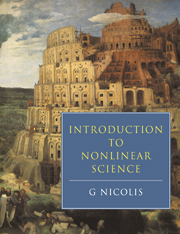Book contents
- Frontmatter
- Contents
- Preface
- 1 Nonlinear behavior in the physical sciences and biology: some typical examples.
- 2 Quantitative formulation
- 3 Dynamical systems with a finite number of degrees of freedom
- 4 Linear stability analysis of fixed points
- 5 Nonlinear behavior around fixed points: bifurcation analysis
- 6 Spatially distributed systems, broken symmetries, pattern formation
- 7 Chaotic dynamics
- Appendices
- References
- Index
7 - Chaotic dynamics
Published online by Cambridge University Press: 05 June 2012
- Frontmatter
- Contents
- Preface
- 1 Nonlinear behavior in the physical sciences and biology: some typical examples.
- 2 Quantitative formulation
- 3 Dynamical systems with a finite number of degrees of freedom
- 4 Linear stability analysis of fixed points
- 5 Nonlinear behavior around fixed points: bifurcation analysis
- 6 Spatially distributed systems, broken symmetries, pattern formation
- 7 Chaotic dynamics
- Appendices
- References
- Index
Summary
The Poincaré map
As we have seen throughout this monograph, in a nonlinear dynamical system the first bifurcation from a fixed point leads to fixed point or to limit cycle behavior. Chaotic behavior. which according to the experimental data surveyed in Chapter 1 is abundant in nature, can therefore arise smoothly from simple fixed point behavior only through a sequence of bifurcations involving high order (tertiary etc.) transitions. As a rule, at some stage of this sequence of transitions a periodic solution loses its stability, a fact that is also reflected in the experimental data where chaotic behavior seems to be much more intimately intertwined with periodic rather than steady-state behavior.
The above comments suggest that to gain an insight into the onset of chaos it is necessary to analyze the loss of stability and the subsequent bifurcation behavior of periodic solutions. Unfortunately, this task is unattainable. First, the analytic form of these solutions in the interesting parameter region is not known except in a number of exceptional situations. Second, even if the analytic form were known one would be led to study dynamical systems of the form of eq. (3.26) in which both the linearized operator and the nonlinear part h contain an explicit periodic dependence in time.
- Type
- Chapter
- Information
- Introduction to Nonlinear Science , pp. 173 - 229Publisher: Cambridge University PressPrint publication year: 1995



